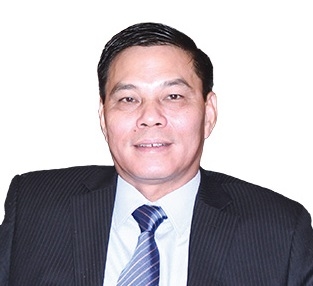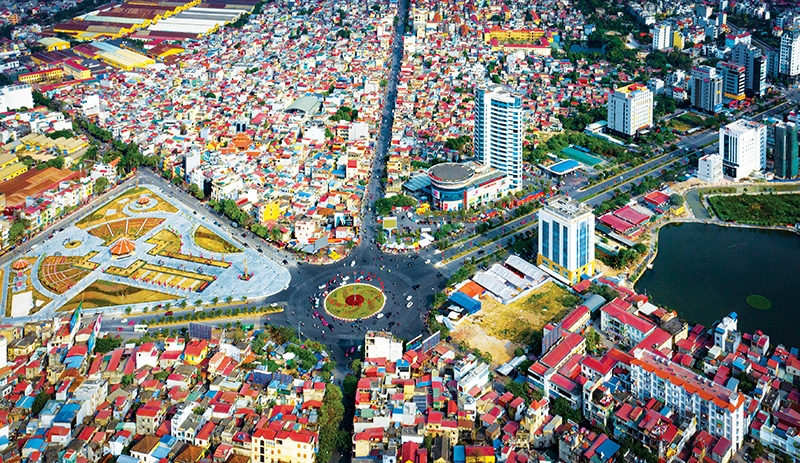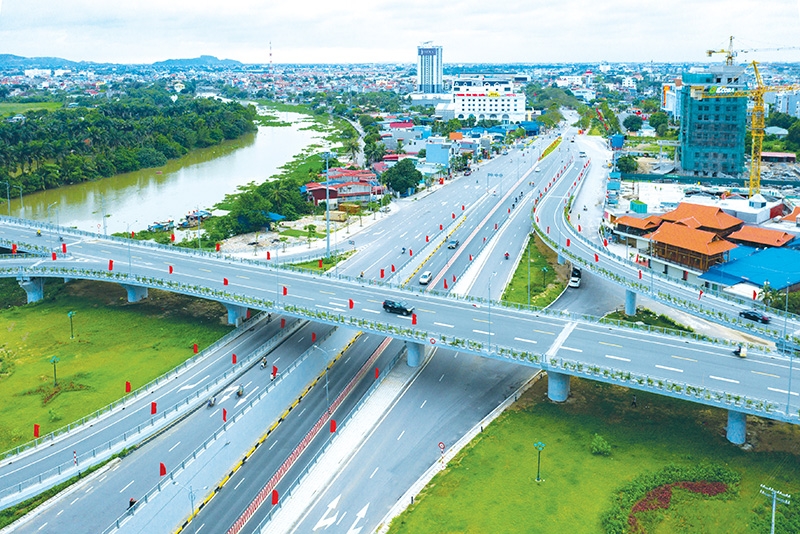The right moves for breakthroughs
Haiphong is faring well with pandemic containment, ensuring economic growth and stabilising people’s livelihoods. Does this prove that the city currently has both a healthy economic and social environment?
 |
| Nguyen Van Tung, Chairman of Haiphong People’s Committee |
Just like other localities, Haiphong has struggled with mounting difficulties through the COVID-19 pandemic. Under the leadership and direction of the Party Central Committee, the government, and Haiphong Party Committee, People’s Council, People’s Committee, and the involvement of the political units, Haiphong has firmly established itself to overcome and develop in a stable and comprehensive manner, becoming a bright spot for the whole country in many fields.
In 2020, the city almost completed key socioeconomic development targets, with a number of high-achieving targets such as GDP per capita, foreign investment attraction, and export turnover, among others. Particularly, the growth rate of regional GDP reached 11.22 per cent, nearly 4 times higher than the national average and much higher than that of the other five centrally-governed cities.
Haiphong has implemented many drastic measures in the collection and management of budget expenditures, ensuring strict, efficient, and economical implementation. As a result, the city posted a domestic budget revenue surpassing VND 32.7 trillion ($1.42 billion), equal to 106 per cent of the initial estimate, an increase of more than 20 per cent compared to 2019.
In the first half of 2021, Haiphong’s economic growth reached a high level compared to the country’s average and other provinces and cities. Accordingly, the regional GDP was estimated to surge by 13.5 per cent on-year, about 2.4 times higher than the national average.
These impressive results have confirmed Haiphong’s business investment environment and production capacity. The city’s Provincial Competitiveness Index in 2020 continued to move up and ranked seventh out of 63 cities and provinces with 69.27 points, the highest rank and score to date.
The socioeconomic development policies have always received the support of the residents and the business community, and have been confirmed by results. Therefore, Haiphong’s pandemic prevention measures have always been strictly followed by the residents, contributing to the success of keeping the area safe and successfully achieving the goals of containing the pandemic and pushing up socioeconomic development.
 |
| Haiphong has planned to replace some older buildings with newer ones to improve living quality. Photo: Hong Phong |
What is the city’s development plan from now to the end of 2025, with a vision to later decades?
The top target set by the Politburo is that by 2045, efforts must be made to turn Haiphong into a city with a high level of development being listed among leading cities in Asia and the world over.
By 2025, Haiphong must attempt to complete the industrialisation and modernisation goals; meeting the criteria for grade I urban areas; becoming an industrial city in the direction of modernity; being the key marine economy of the country; a national logistics service centre and a centre for training, research, application, and development of marine science and technology, and also a fishery logistics, search, and rescue centre for the northern region.
Along with this, Cat Ba and Do Son together with Halong would become world-class tourism venues; in parallel to completing the relocation of the city’s political and administrative centre to the north of the Cam River, and building an urban government with a streamlined apparatus and effective and efficient operation.
By 2030, Haiphong aims to become a modern, smart, and sustainable industrial city of regional level; being a multi-modal modern international logistics service centre; and international centre for the development of science and technology with the strong professions of maritime, oceanography, and the marine economy. Haiphong wants to satisfy the criteria of a special urban area, finalising the conversion of 50 per cent of districts into district administrative units. The urban government will also be built and completed in accordance with the requirements of smart cities.
Focusing on speeding up the progress of important transport infrastructure projects being implemented in Haiphong is also a must. These are new projects and works such as the expansion of Cat Bi International Airport, Nguyen Trai Bridge, Vu Yen II Bridge, Ben Rung Bridge, Rao III Bridge, a new route connecting the city centre to Do Son, ring roads 2 and 3, and new wharves at Haiphong International Gateway Port.
Other tasks of equal importance are proposing the government for investment proposal approval and deployment of the Haiphong-Hanoi-Lao Cai high-speed railway project, striving to have in place a synchronous, modern, and continuous transport infrastructure system by 2025, and becoming an international trade centre and driving force for the economic development of the whole country.
 |
In 2021, many policies and decisions have been issued that have created resonance and high consensus among the city’s residents. What are the notable contents?
One of the key tasks that Haiphong Party Committee cares for is human resources. Over the years, the committee has focused on leading, directing, and consolidating the team of leaders and managers at all levels to ensure quantity and quality; meeting mission requirements. However, in order to ensure human resources to serve the city’s high growth goals in the future, the preparation and training of successive human resources must be carried out.
The Standing Committee of the City Party Committee issued Conclusion No.09-KL/TU on strengthening young officials to hold leadership positions at district and commune levels; and preparing and rotating officials among localities, agencies, and units in the party committee of the city for the term 2020-2025. Following the conclusion, Haiphong will assign an under-35 leader to each district, and each commune and ward has an under-30 vice chairman of the people’s committee to rejuvenate the leader group. Each district will arrange 20-25 per cent of communes, wards, and townships with officials under 30 years old to strengthen the position of the vice chairman of the people’s committee.
Socioeconomic infrastructure development is also put at priority. Accordingly, the city’s urban infrastructure continues to be invested in to further improve the quality of life of local people. From now to 2030, Haiphong will invest in building more than 100 bridges with the total investment exceeding VND83 trillion ($3.6 billion), of which 100 river-crossing bridges, 13 viaducts, and 13 bridges on the ring road would be built.
In order to improve residents’ living space and urban landscape space, Haiphong has deployed the construction of a number of parks across the city’s different areas. By the end of this year we plan to build seven parks in seven districts and 10 parks in different towns, as well as strive to build a green park in each ward by 2025.
In 2021, Haiphong will focus on renovating sidewalks for six downtown streets, including undergrounding all telecommunications cables and power lines. The city is planning to renovate and embellish pavements with about 300 roads in the districts with a total estimated investment reaching VND11 trillion ($478.2 million).
Along with that, improving people’s living quality is also of prime concern by speeding up the construction of new apartments to replace older ones. Efforts will gear towards soon completion of the HH1-HH2 Dong Quoc Binh apartment building for putting into use in the first quarter of 2022, as well as preparing procedures to deploy the construction of other residential blocs such as Van My apartment complex in the city’s Ngo Quyen district, and more.
The project to revise Haiphong’s general planning to 2035 with a vision toward 2050 is being submitted to the prime minister for consideration and approval. In light of the scheme, the Haiphong urban area will be developing under the “multi-centre urban” format, instead of the model of one centre with satellite urban areas as previously.
Simultaneously, the three rivers of Cam, Lach Tray, and Van Uc are being considered as fulcrums, opening up the architectural and ecological landscapes of the city to serve economic development and improve the residents’ living conditions and quality.
In order to materialise the plans, leaders’ accountability, sense of discipline, and civil service quality must be prioritised to promote work efficiency, building trust and consensus among the residents and businesses to boost the efficiency of decision implementation.
What the stars mean:
★ Poor ★ ★ Promising ★★★ Good ★★★★ Very good ★★★★★ Exceptional
 Tag:
Tag:
Related Contents
Latest News
More News
- Haiphong breaks ground on landmark industrial park and LNG power plant (September 28, 2025 | 09:00)
- DEEP C partners with Signify to develop green lighting in industrial zones (August 27, 2025 | 11:01)
- Nam Dinh Vu Industrial Park taps new free trade zone to attract high-quality investment (July 29, 2025 | 14:41)
- Haiphong attracts $15.6 billion in investment (July 16, 2025 | 13:49)
- KinderWorld opens Singapore International School in Haiphong (May 13, 2025 | 14:20)
- Red Flamboyant Festival connecting milestones with ambition (May 13, 2025 | 10:08)
- Haiphong restates its goals with solid fundamentals (May 13, 2025 | 09:57)
- Heroic Haiphong stands tall (May 13, 2025 | 09:38)
- Haiphong’s thrust to go green and digital (May 13, 2025 | 08:00)
- Haiphong private sector emerges as key engine of economic growth (April 21, 2025 | 11:44)
























 Mobile Version
Mobile Version